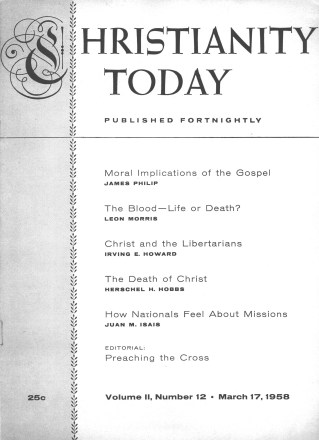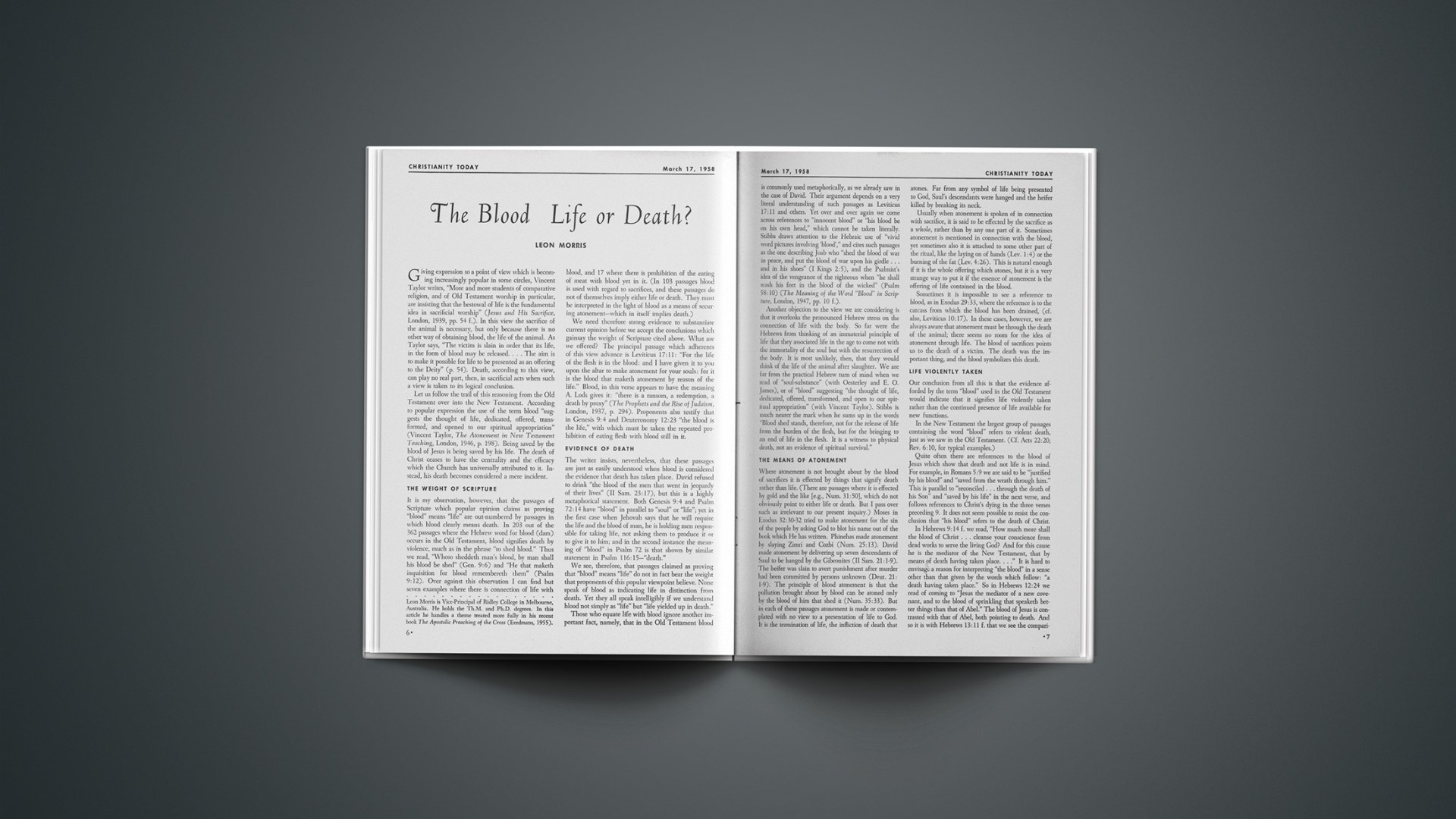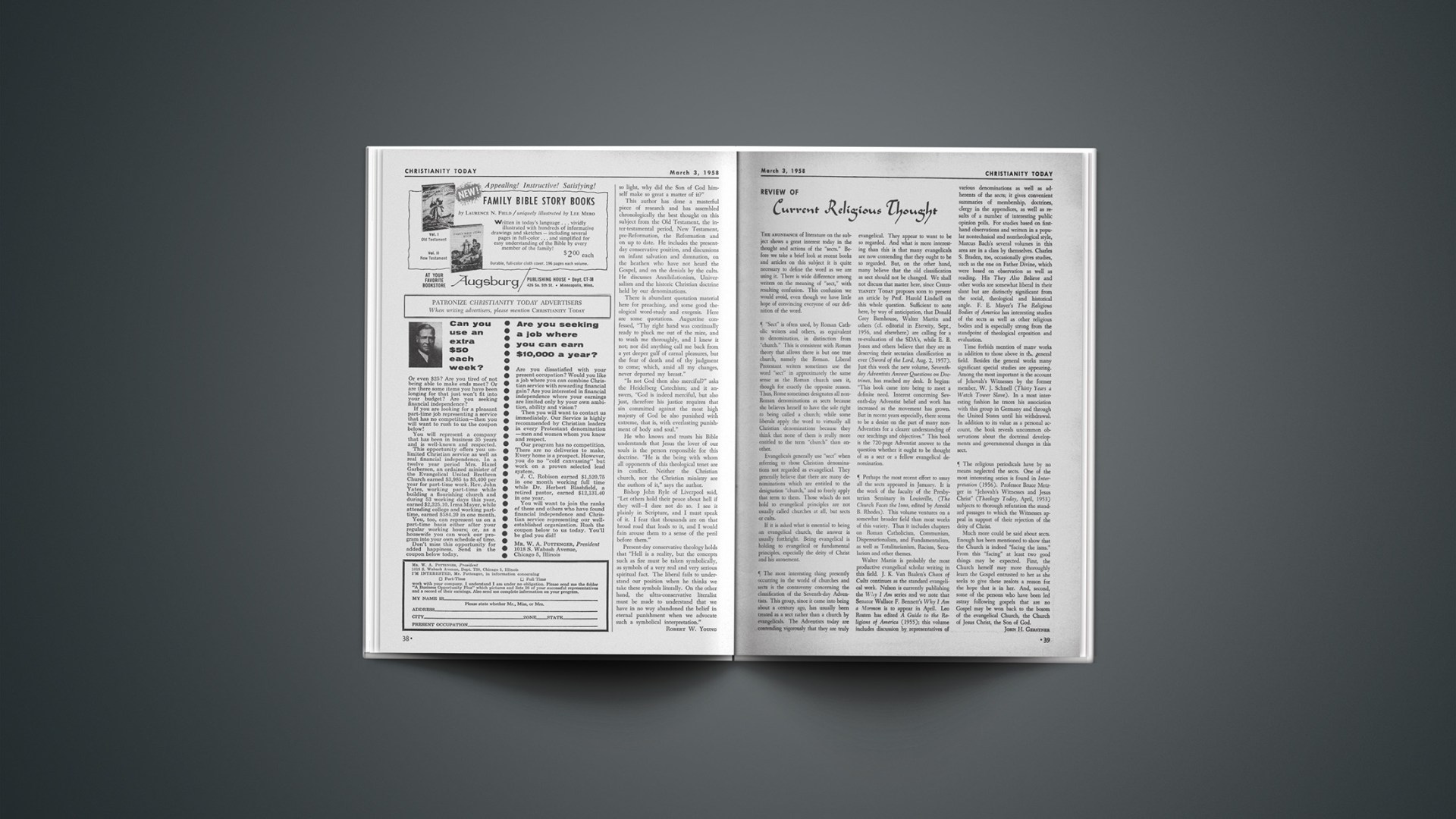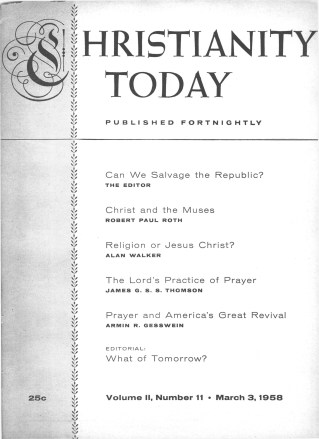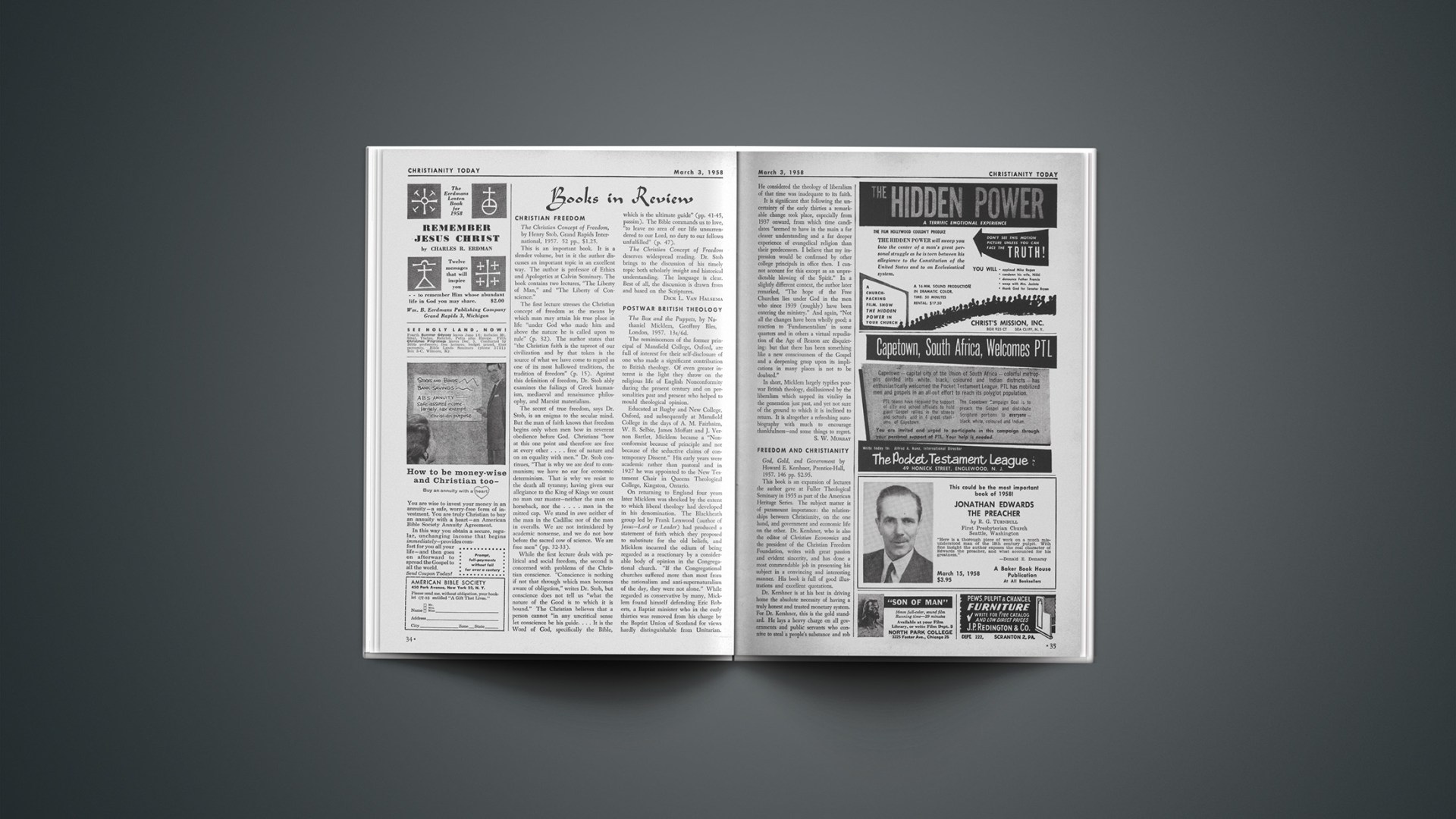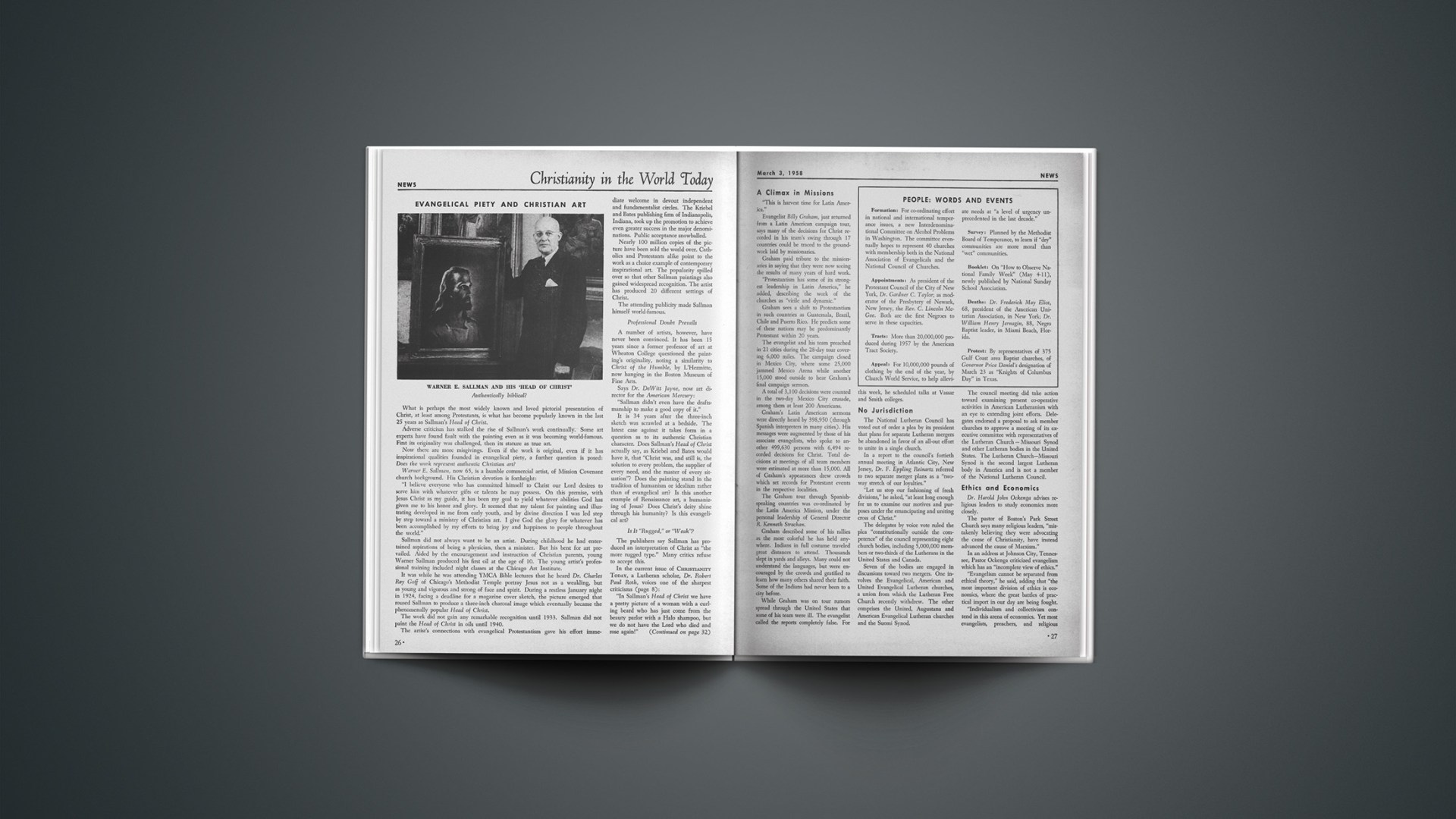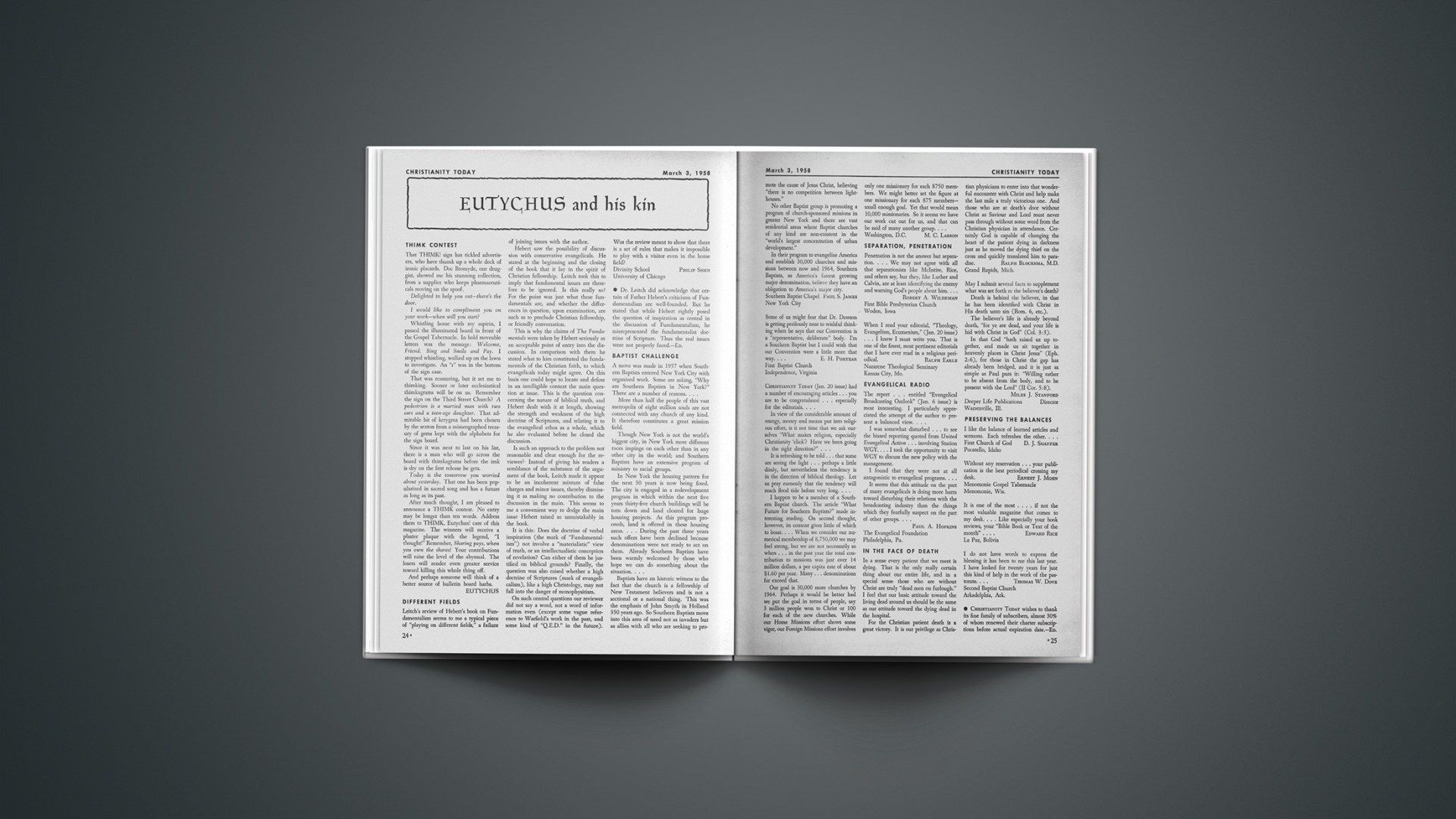“From that time forth began Jesus to shew unto his disciples, how that he must go to Jerusalem, and suffer many things of the elders, and chief priests and scribes, and be killed, and be raised again the third day. Then Peter took him, and began to rebuke him, saying, Be it far from thee, Lord: this shall not be unto thee. But he turned, and said unto Peter, Get thee behind me, Satan: thou art an offence unto me: for thou savourest not the things that be of God, but those that be of men” (Matt. 16:21–23).
Peter came through with flying colors on this examination as to the person of Jesus. But he failed miserably in his understanding of our Lord’s atoning mission. For him there was no place for death in his Christology. To Peter death could mean only defeat for all that was involved in Jesus’ ministry.
That the apostle was not alone in this regard may be seen in an examination of the attitudes held by others with respect to the death of Jesus. To the elders, chief priests, and scribes it was merely the removal of another threat to their privileged position (John 11:48). To the Romans it was only the execution of another criminal (Matthew 27:15–17). To the Greeks it simply involved another foolish sentiment of an unlearned people (1 Cor. 1:23). To the multitude of Jews it was a stumbling block to their faith (1 Cor. 1:23). To Jesus’ most devoted followers his death was a tragic defeat for all their hopes and dreams (Luke 24:21). To all the crucifixion of Jesus was an act of martyrdom to his ideals. In varying degrees all these attitudes have persisted through the centuries even unto this hour.
But to Jesus his own death was the center of history about which all his words and deeds would revolve. To be sure, for many the meaning of Jesus’ death came into proper focus after the Resurrection (Luke 24:25–27). However, there are some who would still stand alongside Peter of long ago and “rebuke” Jesus and those who proclaim him when faced with the facts and implications of his death. His person, character, and teachings they embrace; but for them no cross, no Calvary and no shed blood.
A Voluntary Death
Since Jesus’ death was to him the crux of his ministry and the center of men’s faith, what, then, may we say as to the meaning of it?
That the death of Jesus came as no surprise to him may be seen in that six months before it happened he began to prepare his disciples for that hour (Matt. 16:21). Death had been a reality to him from the beginning. We may well surmise that even as a child he saw himself as the “Lamb slain from the foundation of the world” (Rev. 13:8; cf. Luke 2:49). Certainly it was envisioned by Simeon as he held the infant Jesus in his arms (Luke 2:35). John the Baptist could have had no other thought in mind when he said of him, “Behold, the Lamb of God, which taketh away the sin of the world” (John 1:29). We do not fully comprehend the meaning of the baptism of Jesus until we see in it the symbolic foregleam of his death, burial, and resurrection. The burden of proof rests upon those who would avow that the full significance of Psalm 22 was not understood by Jesus from the beginning of his public ministry (Matt. 27:46; cf. Ps. 22:1).
But all this Jesus kept from his disciples until the pressure of the approach of his death made it necessary that he tell them plainly of his pre-determined end. Shortly after his conversation with Peter, Jesus, in his transfiguration experience, conversed with Moses and Elijah concerning his “decease” or exodus (literal translation) “which he should accomplish at Jerusalem” (Luke 9:31). Thereafter, knowing that “the time was come that he should be received up, he steadfastly set his face to go to Jerusalem” (Luke 9:51), knowing what awaited him there.
This truth comes more into focus as, later in Jerusalem, we hear him say, “No man taketh it [my life] from me, but I lay it down of myself. I have power to lay it down, and I have power to take it again” (John 10:18). Still nearer to that event, and in reply to those who warned him of Herod Antipas, Jesus says, “Go ye, and tell that fox, Behold, I cast out devils, and I do cures today and tomorrow, and the third day I shall be perfected.… for it cannot be that a prophet perish out of Jerusalem” (Luke 13:32 f.). The time of Jesus’ death lay, therefore, not within the whim of Herod but within the wisdom of Jesus. And two days before his crucifixion he predicted the exact day on which it would occur (Matt. 26:2).
The picture of the voluntariness of Jesus’ death becomes even clearer as the hour of it draws nearer. Under the shadow of Gethsemane’s gnarled boughs, when Peter rashly attempts to save him from his arrestors, Jesus allows himself to be taken with the avowal, “Thinkest thou that I cannot now pray to my Father, and he shall presently give me more than twelve legions of angels? But how then shall the scriptures be fulfilled, that thus it must be?” (Matt. 26:53 f., author’s italics).
A careful analysis of Jesus’ trial and crucifixion reveals that through it all he was in complete command, to die not as a martyr nor criminal but as a king. In the midst of his trial he reminded Pilate, who said he possessed the power to release or crucify him, “Thou couldst have no power at all against me, except it were given thee from above.…” (John 19:11). And at his crucifixion, he caused Pilate to write in the languages of government (Latin), of culture (Greek), and of religion (Hebrew), “JESUS OF NAZARETH THE KING OF THE JEWS” (John 19:19).
But the climax of this truth is seen in the moment Jesus died. Matthew records that when He “cried again with a loud voice, he yielded up the ghost” (27:50). Translated literally we read, “He dismissed his spirit.” That is, when all was accomplished according to divine plan, Jesus said to his spirit, “You can go now!” This was a voluntary death!
Looking back from that juncture in time, we realize, therefore, that our Lord was not swallowed up in a swirling maelstrom of circumstances. Rather he walked with certainty and dignity to the cross as he perfectly did always the will of his Father. On the cross he refused the merciful relief of drugs that in full possession of his mental powers he might lay down his life as a sacrifice for the sin of the world. Having known no sin he voluntarily became sin for us that in his death the power of sin over us might be broken. Nothing short of this would have sufficed. Animals by the unnumbered thousands had hitherto gone to the altar as unknowing and unwilling victims. Yet, they were but shadows of the Lamb of God, the Son of man, who willingly gave his life as a ransom for many.
A Vicarious Death
A vicarious death simply means a substitutionary death. In his crucifixion Jesus was our substitute, bearing the penalty for our sins. This is seen in Jesus’ becoming the substitute for Barabbas. According to Roman custom, the Jews had the privilege of selecting one prisoner to be released for them at the season of the Passover. Knowing this, and hoping thus to release Jesus, Pilate asked the crowd whom they would have released unto them, Barabbas, a notable prisoner accused of insurrection, murder, and robbery, or Jesus. At the instigation of the chief priests and elders, the people chose Barabbas and called for the crucifixion of Jesus (Matt. 27:15–22). Thus, when our Lord died between two thieves he was actually a substitute for the sinner, Barabbas.
In actuality, of course, Jesus died not merely as the substitute for one man, but for all men (1 Tim. 2:6). This truth is clearly taught in the Bible. More than seven hundred years before that event Isaiah spoke of One who “hath borne our griefs, and carried our sorrows,” of One who was “wounded for our transgressions … bruised for our iniquities; the chastisement of our peace was upon him; and with his stripes [bruises] we are healed. All we like sheep have gone astray.… and the Lord hath laid on him the iniquity of us all” (53:3–6). Literally, the Lord “hath made the iniquity of us all to meet on him.”
Jesus’ vicarious death is the theme also of John 1:29: “Behold the Lamb of God, the One bearing away the sins of the world” (literal translation). The words “bearing away” mean to take upon one’s self and carry that which has been raised by another. Thus Jesus became the scapegoat of the New Testament as he took upon himself the sins of the world.
Every man, were he to bear to his own death his own sins, would fall under the weight of the burden and be unable to carry them away. For this reason God mercifully raises our sins off from us and places them upon Jesus, the Lamb of God, who in turn carries them for us in death as our Substitute.
It is significant that a few weeks before Jesus’ death, Caiaphas, the high priest, had pointed out to his colleagues that it was expedient that “one man should die for (author’s italics) the people, and that the whole nation perish not” (John 11:50). John comments that Caiaphas had unknowingly “prophesied that Jesus should die for that nation; and not for that nation only, but that also he should gather together in one the children of God that were scattered abroad” (11:51 f.). This word for is indeed significant, for Jesus uses it in explaining the purpose of his death: “I lay down my life for (author’s italics) the sheep” (John 10:15), that “whosoever believeth in him should not perish, but have everlasting life” (John 3:16). Had the justice of God prevailed Barabbas, not Jesus, would have been crucified. But because his judgment is wielded in mercy, Barabbas and all other sinners may go free.
Jesus Christ was our Substitute. And as we lift our eyes to see him hanging on a tree, we must avow, “But for the grace of God, there hang I!”
A Votive Death
The word “votive” is an adjective describing that which is offered or given in consecration or fulfillment of a vow. The last words of Jesus before he died were, “It is finished!” (John 19:30). In the language of the New Testament these words have to do with reaching an intended goal, carrying out the contents of a command, or performing the last act required to complete a process. In John 19:28 we read, “After this, Jesus knowing that all things were now accomplished, that the Scripture might be fulfilled, saith, I thirst” (author’s italics). The verb in italics is the same word in a passive form of the word “finished.” Jesus’ intended goal had been reached, the command had been fully obeyed and the process completed. And when he had received the vinegar, he said, “It is finished!” and bowed his head and gave up the ghost.
In the Epistle to the Hebrews the author interprets the death of Jesus as the fulfillment of the new covenant which God had made with men (Jer. 31:31–34; Heb. 8:6–10:22). He pictures the crucified Son of God as the “mediator of the new testament” (9:15). Pointing out the insufficiency of animal sacrifice for man’s sin (10:4), he adds, “Wherefore when he cometh into the world, he saith, Sacrifice and offering thou wouldst not, but a body hast thou prepared me … then said I, Lo, I come (in the volume of the book it is written of me,) to do thy will, O God” (10:5–7). That the will of God involved Jesus’ death for man’s sin is made clear by the author’s assertion, “But this man, after he had offered one sacrifice for sins for ever, sat down on the right hand of God” (10:12).
Thus we are carried back into the council chambers of eternity, where, in keeping with the redemptive purpose of God, the Lamb was slain from the foundation of the world (Rev. 13:8). But this redemption had to be worked out in history. The Father had to prepare a body in which the Son could be incarnated. And in this body Jesus justified the law of God in that he was tempted in all things like as we are, yet without sin (Heb. 4:15). Still he was made to become sin for our sakes “that we might be made the righteousness of God in him” (2 Cor. 5:21). It was to this that Jesus referred in his Gethsemane prayer. But he drew not back from the complete will of God. Jesus was nailed to the cross, God “made the iniquity of us all to meet on him” (Isa. 53:6), and God thereby poured out his wrath upon sin. In short, Jesus placed himself upon the sacrificial altar as a votive offering for sin.
A Victorious Death
If the death of Jesus had ended with the cry “It is finished,” our hopes would be futile. Such an end would have been defeat indeed. But the glorious epilogue to the redemptive drama is one of victory. Three days after his death some women came to his tomb prepared to anoint his body with spices for permanent burial. When they arrived they found the tomb opened and an angel sitting at the doorway. Seeing they were afraid the angel said to the women, “Fear not ye: for I know that ye seek Jesus, which was crucified. He is not here: for he is risen, as he said.…” (Matt. 28:5 f.).
“As he said …!” It was in the foreknowledge of Jesus that beyond the cross would be the empty tomb. And he had spoken of this in many ways. At his baptism had he not come up out of the watery grave? At the first unveiled pronouncement of his death, had he not said, “Destroy this temple, and in three days I will raise it up” (John 2:19)? And when asked for a sign as to his deity, had Jesus not given the people the sign of Jonah, “For as Jonas was three days and three nights in the whale’s belly; so shall the Son of man be three days and three nights in the heart of the earth” (Matt. 12:40)? Yet, they understood him not.
They understood not that the victorious climax to Jesus’ earthly ministry would be in the resurrection. It was to be the basis of hope for all who should believe in him. “Because I live, ye shall live also” (John 14:19). He was declaring that assurance when he said to Martha, “I am the resurrection and the life: he that believeth in me, though he were dead, yet shall he live: and whosoever liveth and believeth in me shall never die. Believest thou this?”
In this question lies the very essence of our faith. The preaching of the first century did not stop with the crucifixion, but went on to the resurrection. And so must ours! Without that glorious truth we have no gospel, no forgiveness, no hope (1 Cor. 15:14–19). “But now is Christ risen from the dead, and become the firstfruits of them that slept” (v. 20). The “firstfruits” is the certainty that those in Christ may declare, “But thanks be unto God, which giveth us the victory through our Lord Jesus Christ” (v. 57).
I Hold The Book
Here in my hands I hold the Holy Book.
Like silence coming after battle roar,
Now peace comes home, and all the storms that shook
The heart’s foundation are no more, no more.
Now unafraid, I watch the level length
Of shadows deepen into darkest night:
Here in my hands is quietness and strength,
Here in my hands is gentleness and might.
Though satellites may whirl in outer space,
And hearts may faint with fear, this heart of mine
Is confident. I hold the Book and trace
God’s faithfulness in every single line.
And though the midnight of the world be nearing,
I face the dawn, the day of His appearing.
HELEN FRAZEE-BOWER
Herschel H. Hobbs holds the Th.M. and Ph.D. degrees from Southern Baptist Seminary. Pastor of First Baptist Church. Oklahoma City, he serves in the Southern Baptist Convention.

